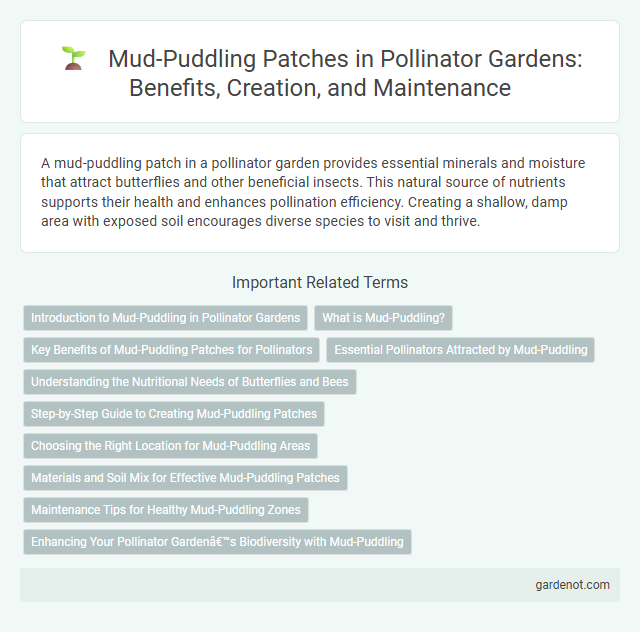A mud-puddling patch in a pollinator garden provides essential minerals and moisture that attract butterflies and other beneficial insects. This natural source of nutrients supports their health and enhances pollination efficiency. Creating a shallow, damp area with exposed soil encourages diverse species to visit and thrive.
Introduction to Mud-Puddling in Pollinator Gardens
Mud-puddling patches in pollinator gardens provide essential minerals and nutrients like sodium and amino acids that many pollinators, especially butterflies, seek for energy and reproduction. These damp, nutrient-rich soil areas attract various insects, enhancing biodiversity and promoting pollination effectiveness. Incorporating mud-puddling sites supports healthy pollinator populations by meeting their vital ecological needs within garden environments.
What is Mud-Puddling?
Mud-puddling is a behavior observed in pollinators, primarily butterflies and some bees, where they seek out moist soil, mud, or puddles to extract essential minerals and nutrients such as salts and amino acids. These nutrients are crucial for reproductive success, enhancing butterfly fertility and vitality. Creating a dedicated mud-puddling patch in a pollinator garden supports biodiversity by providing a vital resource often scarce in typical garden environments.
Key Benefits of Mud-Puddling Patches for Pollinators
Mud-puddling patches provide essential minerals and nutrients that pollinators, especially butterflies and bees, extract from moist soil or mud. These patches support pollinator health by enhancing reproduction, improving vitality, and boosting resilience against environmental stresses. Incorporating mud-puddling areas into pollinator gardens fosters biodiversity and strengthens the local ecosystem.
Essential Pollinators Attracted by Mud-Puddling
Mud-puddling patches attract essential pollinators such as butterflies, bees, and moths seeking minerals and moisture necessary for their survival and reproduction. These pollinators extract vital nutrients like sodium and amino acids from wet soil or mud, enhancing their energy and fertilization capacities. Incorporating mud-puddling areas in pollinator gardens supports biodiversity by providing critical habitat resources for these beneficial insects.
Understanding the Nutritional Needs of Butterflies and Bees
A mud-puddling patch provides essential minerals and nutrients such as sodium, amino acids, and trace elements necessary for the survival of butterflies and bees. These pollinators extract vital nutrients from moist soil to aid in reproduction, wing strength, and overall energy metabolism. Creating a habitat with rich, damp soil near flowers enhances pollinator health and supports biodiversity within a pollinator garden.
Step-by-Step Guide to Creating Mud-Puddling Patches
Creating a mud-puddling patch begins with selecting a sunny, sheltered area in your pollinator garden, then digging a shallow depression about 6-12 inches wide and 2-3 inches deep. Fill the patch with a mixture of clay-rich soil, sand, and organic matter to retain moisture while providing minerals essential for butterflies and bees. Maintain consistent dampness by watering regularly, avoiding standing water to attract pollinators seeking nutrients from the wet soil.
Choosing the Right Location for Mud-Puddling Areas
Selecting the ideal location for mud-puddling patches involves identifying sunny, sheltered spots near nectar sources where soil retains moisture without flooding. Soil rich in minerals like sodium and calcium promotes butterfly and bee activity essential for pollination. Positioning these patches close to native flowering plants enhances accessibility and supports diverse pollinator species throughout the growing season.
Materials and Soil Mix for Effective Mud-Puddling Patches
An effective mud-puddling patch requires a soil mix rich in clay, sand, and organic matter to retain moisture and provide essential minerals for pollinators. Incorporating decomposed leaf litter and compost enhances nutrient availability and supports a healthy microhabitat. Using materials like fine gravel and loamy soil creates a stable surface that attracts butterflies and bees for mineral absorption.
Maintenance Tips for Healthy Mud-Puddling Zones
Maintaining a healthy mud-puddling patch requires regular moisture management to keep the soil consistently damp but not waterlogged, promoting nutrient uptake for pollinators like butterflies. Removing debris and preventing algae buildup ensures an accessible and clean environment for insects seeking minerals. Periodic soil replenishment with natural clay and organic matter enhances the patch's texture and mineral content, supporting vibrant pollinator activity.
Enhancing Your Pollinator Garden’s Biodiversity with Mud-Puddling
Incorporating a mud-puddling patch in your pollinator garden attracts essential insects like butterflies and bees by providing a vital source of minerals and moisture. This natural behavior supports their nutrition, promoting healthier pollinators that enhance overall garden biodiversity. Strategic placement of shallow, damp soil areas enriched with organic matter encourages sustained visitation, boosting pollination success and ecosystem resilience.
Mud-puddling patch Infographic

 gardenot.com
gardenot.com